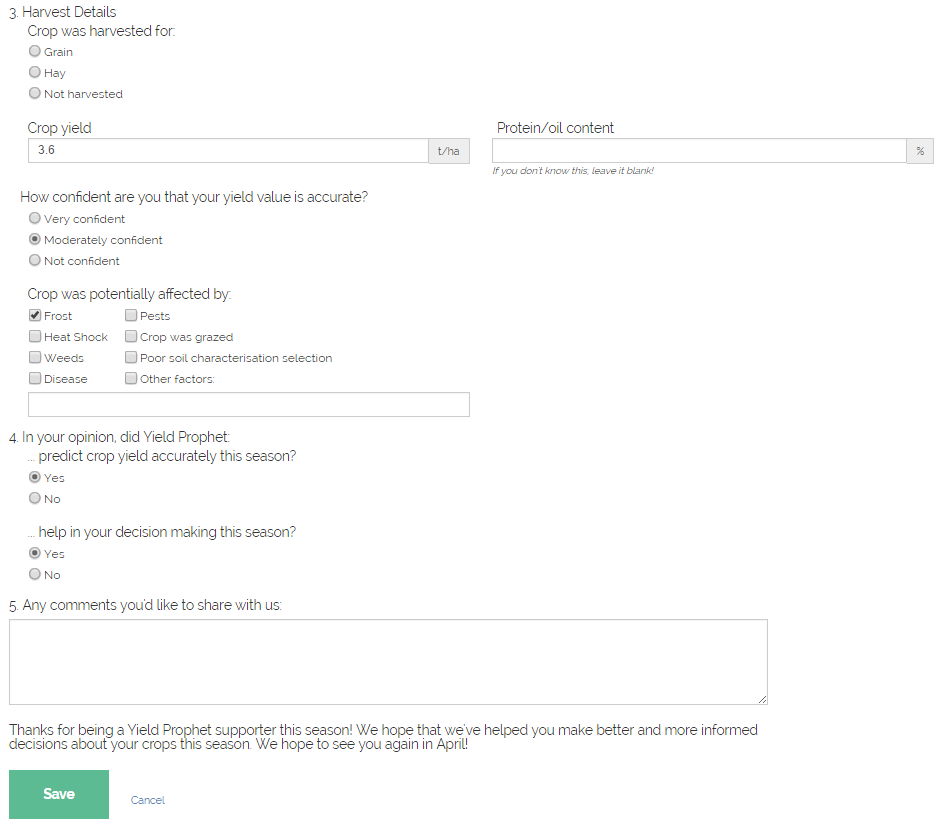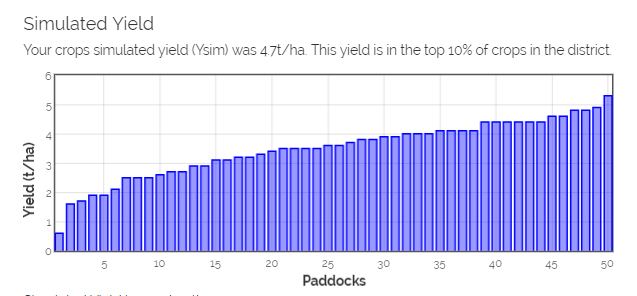The 2016 season will see the introduction of a new season review for paddocks in Yield Prophet. The purpose of this process is to provide you with more information about your crop and create an opportunity to benchmark your crop's performance.
As the saying goes: “There is always room for improvement”. An important part of improving your farm performance is to review the season that has just passed. How did you go? What could you have done better?
The season review will provide:
· a comparison of paddock yield, simulated yield and water limited yield in order to identify any yield gap between actual and potential crop yield,
· your calculated water use efficiency based on the French and Shultz equation,
· a comparison of your simulated yield with other simulated crop yields in the district, and
· a chart of simulated yields by sowing time in the district.
The process
If you have:
· Your crop yield
· Protein or oil content
· And your opinion about how Yield Prophet performed
You are ready to go! Generating this review is very simple and takes less than 5 minutes per paddock.
The season review option is only available once Yield Prophet has simulated crop maturity.
Getting started
When you log into Yield Prophet, a dashboard appears with a tile for each subscribed paddock. When your simulated crop growth stage is at maturity you will see the tile relating to that paddock now has a button “Begin season review”. To begin, click on this button.

Follow the prompts on screen and answer each question as it comes.

Then the following will appear asking you to ‘ground truth’ rainfall, nitrogen and irrigation information about your paddock. Check the rainfall, nitrogen and irrigation inputs for accuracy. If you click “Yes” you will be asked further questions. If the recorded rainfall and applications are not right, click “No” and you can go back and adjust the inputs accordingly.

Once the rainfall and inputs are right, you will be asked questions 3 through to 5. Make sure the data you enter is as accurate as possible.

Then click on “Save” which will trigger the review in progress.
You’ll be taken back to the general dashboard and an automatic report and the tile will appear once the Review is completed.

Features
You’ll receive your review by email or via the Yield Prophet website. You can view it on the website by clicking on ‘View End of Season Review’ on the associated paddock tile. It provides a one-page summary of your crop performance including a comparison of the predicted yield and benchmark indicators including
- calculated water use efficiency
- sowing date and
- simulated yield
Now you can start thinking about your crop performance and how to improve it in the future.

The review shows a yield gap of 1.1 t/ha between the actual yield (3.6 t/ha) and the simulated yield (4.7 t/ha and an extra 0.5 t/ha lost from severe frost and heat shock taking it a 1.5 t/ha production gap. Yield Prophet has simulated that 0t/ha of this gap is a result of insufficient nitrogen.
The Sowing Time graph shows that this paddock was in the first quarter of Yield Prophet wheat crops sown in the district. This graph shows distribution of sowing dates in the region and this paddock was sown relatively early.
However in the following graph, the 4.7t/ha potential yield was in the top 10% of wheat crops grown in the district demonstrating the relatively high production capacity of this paddock.

What now?
This review can then raise questions about the production of this paddock and highlight future yield goals to aim for.
· What other factors could have contributed to yield loss?
· Weeds, pest pressure, storm damage or moisture stress at various times?
· And what can you do to manage them these factors in the future?